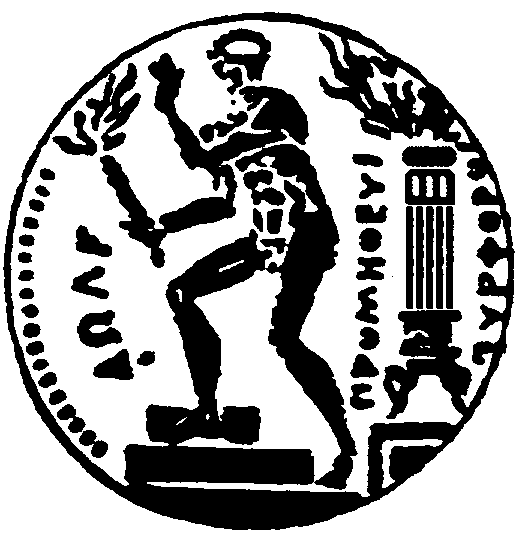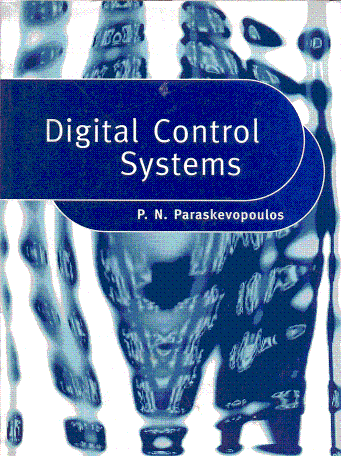
Παρασκευάς Ν. Παρασκευόπουλος
Digital Control Systems
 Βιβλιο
[11]
Βιβλιο
[11]
[11] P.N. Paraskevopoulos, Digital Control Systems, Prentice Hall, London, 1996, σελ. 384, (English translation of book 3)
Το βιβλίο αυτό είναι η μετάφραση του βιβλίου [3], ή ισοδύναμα του Πρώτου Μέρους του βιβλίου [6] στα Αγγλικά.
|
CONTENTS
PREFACE 2 CONTENTS 5 CHAPTER 1. INTRODUCTION TO DIGITAL CONTROL SYSTEMS 11 1.1. General introduction 11 1.2. Brief historical overview of control systems 12 1.3. The basic structure of digital control systems 13 1.4. References 16 CHAPTER 2. THE Z-TRANSFORM 22 2.1. Introduction 23 2.2. The basic discrete-time control signals 23 2.3. The Z-transform 26 2.3.1. Introduction to Z-transform 26 2.3.2. Properties and theorems of Z-transform 29 2.4. The inverse Z-transform 37 2.5. Certain interesting Z-transform application examples 40 2.6. References 45 2.7. Problems 45 CHAPTER 3. DESCRIPTION AND ANALYSIS OF DISCRETE-TIME AND SAMPLED DATA SYSTEMS 46 3.1. Introduction 46 3.2. Description and analysis of discrete-time systems 48 3.2.1. Properties of discrete-time systems 48 3.2.2. Description of linear time-invariant discrete-time systems 49 3.2.3. Analysis of linear time-invariant discrete-time systems 53 3.2.4. Description and analysis of linear time-varying discrete-time systems 64 3.3. Description and analysis of sampled-data systems 65 3.3.1. Introduction to D/A and A/D converters 65 3.3.2. Hold circuits 66 3.3.3. Conversion of G(s) to G(z) 69 3.3.4. Conversion of differential state-space equations to difference state-space equations 75 3.3.5. Analysis of sampled-data systems 79 3.4. Determination of closed-loop system transfer functions 82 3.5. References 85 3.6. Problems 86 CHAPTER 4. STABILITY, CONTROLLABILITY AND OBSERVABILITY 90 4.1. Introduction 90 4.2. Definitions and basic theorems of stability 90 4.2.1. Stability of linear time-invariant discrete-time systems 91 4.2.2. Bounded-input bounded-output stability 92 4.3. Stability criteria 94
4.3.1.
The Routh criterion using the Mobius 4.3.2. The Jury criterion 96 4.3.3. Stability in the sense of Lyapunov 101 4.3.4. Influence of pole position on the transient response 103 4.4. Controllability and observability 105 4.4.1. Controllability 105 4.4.2. Observability 108 4.4.3. Loss of controllability and observability due to sampling 110 4.4.4. Geometric considerations of controllability 111 4.4.5. Geometric considerations of observability 113 4.4.6. State vector transformations - state space canonical forms 115 4.4.7. Kalman decomposition 120 4.5. References 121 4.6. Problems 123 CHAPTER 5. CLASSICAL DESIGN METHODS 125 5.1. Introduction 125
5.2.
Discrete-time controllers derived from 5.2.1. Discrete-time controller design using indirect techniques 126 5.2.2. Specifications of the transient response of continuous-time systems 127 5.3. Controller design via the root-locus method 139 5.4. Controller design based on the frequency response 147
5.4.1. Introduction 147 5.4.2. Bode diagrams 150 5.4.3. Nyquist diagrams 158 5.5. The PID controller 159 5.5.1. Proportional controller 159 5.5.2. Integral controller 159 5.5.3. Derivative controller 160 5.5.4. The three term PID controller 160 5.5.5. Design of PID controllers using the Ziegler-Nichols method 161 5.6. Steady-state error 164 5.7. References 168 5.8. Problems 169 CHAPTER 6. STATE-SPACE DESIGN METHODS 172 6.1. Introduction 172 6.2. The pole-placement design method 173 6.3. Deadbeat control 185 6.4. State observers 189
6.4.1. Direct state vector estimation 189
6.4.2.
State-vector reconstruction using a Luenberger 6.4.3. Reduced-order observers 200 6.4.4. Closed-loop system design using state observers 204 6.5. References 6.6. Problems CHAPTER 7. OPTIMAL CONTROL 217 7.1. Introduction 217
7.2.
Mathematic background for
the study of optimal
control 7.2.1. Maxima and minima using the method of calculus of variations 217 7.2.2. The maximum principle for discrete-time systems 220 7.3. The optimal linear regulator 225 7.4. The special case of time-invariant systems 233 7.5. References 236 7.6. Problems 237 CHAPTER 8. DISCRETE-TIME SYSTEM IDENTIFICATION 239 8.1. Introduction 239 8.2. OFF-LINE parameter estimation 240 8.2.1. First-order systems 240 8.2.2. Higher order systems 245 8.3. ON-LINE parameter estimation 252 8.4. References 263 8.5. Problems 264 CHAPTER 9. DISCRETE-TIME ADAPTIVE CONTROL 267 9.1. Introduction 267 9.2. Adaptive control with the gradient method (MIT rule) 270 9.2.1. Introduction 270 9.2.2. Results for the general case of linear systems 274 9.3. Adaptive control using a Lyapunov design 277 9.4. Model Reference Adaptive control-Hyperstability design 282 9.4.1. Introduction 282 9.4.2. Definition of the model reference control problem 283 9.4.3. Design in the case of known parameters 286 9.4.4. Hyperstability design in the case of unknown parameters 290 9.5 Self-Tuning Regulators 305 9.5.1. Introduction 305 9.5.2. Regulator and tracking with minimum variance control 307 9.5.3. Pole placement Self-Tuning Regulators 314
9.6
References
328 CHAPTER 10. REALIZATION OF DISCRETE-TIME CONTROLLERS AND QUANTIZATION ERRORS 334 10.1. Introduction 334 10.2. Hardware controller realization 334 10.2.1. Direct realization 335 10.2.2. Cascade realization 337 10.2.3. Parallel realization 342 10.3. Software controller realization 347 10.4. Quantization errors 349 10.4.1. Fixed point and floating point representations 349 10.4.2. Truncation and rounding 351 10.4.3. A stochastic model for the quantization error 354 10.4.4. Propagation of the quantization error through transfer functions 357 10.4.5. Loss of controllability and quantized closed-loop poles due to quantization 362f 10.5. References 3621 10.6. Problems 362m CHAPTER 11. AN INTELLIGENT APPROACH TO CONTROL: FUZZY CONTROLLERS 363 11.1. Introduction to intelligent control 363 11.2. General remarks on fuzzy controllers 364 11.3. Fuzzy sets 366 11.4. Fuzzy controllers 370 11.5. Elements of a fuzzy controller 372 11.6. Fuzzification 374 11.7. The rule base 374 11.8. The inference engine 375 11.9. Defuzzification 385 11.10. Performance assessment 386 11.11. Application example: kiln control 387 11.12. References 391 11.13. Problems 393 APPENDIX A. MATRIX THEORY 395 A.I. Matrix definitions and operations 395 A. 1.1. Matrix definitions 395 A. 1.2. Matrix operations 398 A.2. Determinant of a matrix 399 A.3. The inverse of a matrix 400 A.4. Matrix eigenvalues and eigenvectors 400 A.5. Similarity transformations 403 A.6. The Cayley-Hamilton theorem 406 A.7. Quadratic forms and Sylvester theorems 408 APPENDIX B. Z TRANSFORM TABLES 411 B.I. Properties and theorems of Z transform 411 B.2. Z transform pairs 413 INDEX 416
|